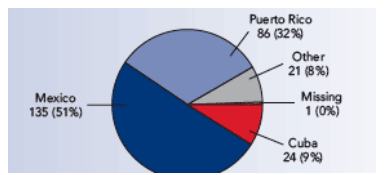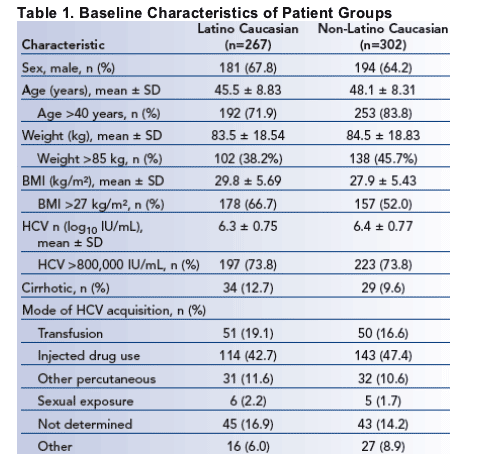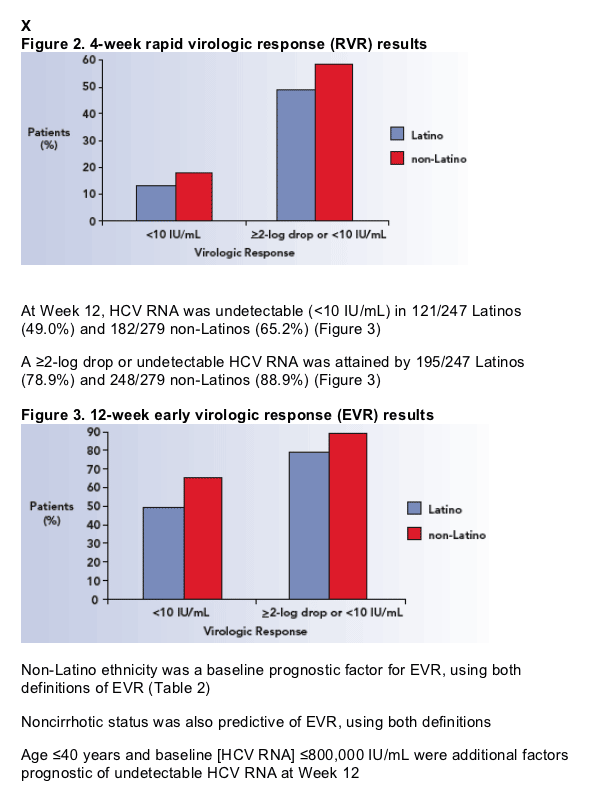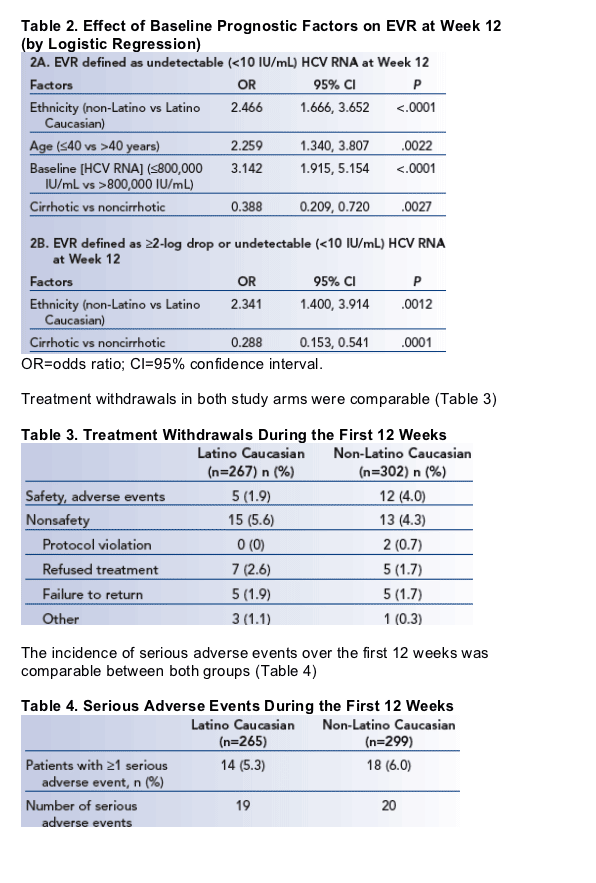 |
 |
 |
| |
LATINO Pegasys Study: early responses
|
| |
| |
Reported by Jules Levin
AASLD, Oct 27-31, 2006, Boston, MA
Rapid and Early Virologic Responses to Peginterferon Alfa-2a Plus Ribavirin in Treatment-Naive Latino vs non-Latino Caucasians Infected With HCV Genotype 1: the LATINO Study
Maribel Rodriguez-Torres, MD1; Victor Ankoma-Sey, MD2; Muhammad Y. Sheikh, MD3; Lorenzo Rossaro, MD4; Fayez M. Hamzeh, MD, PhD5; Lennox J. Jeffers, MD6; on behalf of the LATINO Study Group
1Fundacion de Investigacion de Diego, San Juan, Puerto Rico; 2University of Texas Medical School and St. Luke's Episcopal Hospital Center for Liver Disease, Houston, Tex; 3University Medical Center, Fresno, Calif;
4University of California-Davis Medical Center, LB23 Sacramento, Calif; 5Roche Laboratories, Nutley, NJ; 6Miller School of Medicine, University of Miami, Miami, Fla
Introduction
Results from the 2000 US Census showed that 35.6 million Americans, or 12.6% of the total population, were of Latino origin.1
The US Census Bureau has estimated that the Latino population would increase to 47.8 million individuals, or 15.5% of the total population, by 2010.1
Latinos have been underrepresented in clinical trials of peginterferon plus ribavirin treatment of patients with chronic hepatitis C.2
Although the seroprevalence of chronic hepatitis C has declined in the Latino population, from 2.1% in 1988-1994 to 1.3% in 1999-2002, both histological activity and fibrosis progression rate were significantly higher in Latinos than in non-Latino Caucasians or in non-Latino African Americans.2-4
To date, prospective studies evaluating the response rate of Latino Caucasians to hepatitis C virus (HCV) therapy have been very limited.
The LATINO Study was designed to compare the responses of Latino and non-Latino Caucasians infected with HCV genotype 1 to treatment with peginterferon alfa-2a plus ribavirin.
This is the first multisite, randomized, prospective study examining the efficacy of HCV treatment in Latinos.
This interim analysis shows rapid virologic response (RVR) and early
virologic response (EVR) rates in the 2 groups of patients.
Conclusions
At Weeks 4 and 12, the percentage of non-Latino Caucasian patients with undetectable HCV RNA was higher than that of Latino Caucasian patients.
At Weeks 4 and 12, the percentage of non-Latino Caucasians with undetectable HCV RNA or a ≥2-log decrease in HCV RNA concentration was higher than that of Latino Caucasians.
Regression analysis showed that non-Latino ethnicity was predictive of EVR
Combination therapy was safe in both populations, with few serious adverse events reported..
To date, few patients have withdrawn from the study for either safety or nonsafety reasons.
This ongoing trial will show whether these trends hold over the long term and whether sustained virologic response rates differ.
METHODS
Patients
The trial was a prospective, multicenter, open-label, nonrandomized, comparative efficacy study of peginterferon alfa-2a plus ribavirin in male and female treatment-naive Latino Caucasian and non-Latino Caucasian patients infected with HCV genotype 1.
The study was designed to treat 270 Latino and 270 non-Latino Caucasians.
Latino ethnicity was defined as the sharing of a common Hispanic heritage
- Spanish was primary language
- Both parents and all grandparents had to be Latinos
Latino patients were defined as those from Mexico, Puerto Rico, Cuba, the Dominican Republic, Central America (Costa Rica, El Salvador, Guatemala, Honduras, Nicaragua, and Panama), and South America (Argentina, Bolivia, Chile, Colombia, Ecuador, Paraguay, Peru, Uruguay, and Venezuela) (Figure 1)
- Indian, Asian, or black Latinos were excluded

The 21 patients listed as "other" included 3 from the Dominican Republic; 2 each from El Salvador, Guatemala, and Venezuela; 1 each from Colombia, Ecuador, Nicaragua, Panama, Peru, and Spain; 5 as of "more than one Latino origin"; and 1 as "Mexican and unknown."
Key inclusion criteria:
- Age between 18 and 65 years
- Serologic activity of HCV infection by an anti-HCV antibody test
- Serum HCV-RNA concentration ≥10 IU/mL, as demonstrated by the Roche High Pure System/COBAS TaqMan HCV Monitor Test
- Alanine aminotransferase (ALT) above the upper limit of normal within 12 months prior to treatment
- Liver biopsy showing chronic liver disease consistent with HCV infection within 18 months prior to treatment
- Compensated liver disease, Child-Pugh Class A ≦6, with or without cirrhosis
Treatment
All patients were treated with 180 ug/week peginterferon alfa-2a plus 1000 or 1200 mg/day ribavirin for 48 weeks
HCV RNA was quantified using the Roche High Pure System/COBAS TaqMan HCV Monitor Test
Compared with standard polymerase chain reaction (PCR) tests, the Roche High Pure System/COBAS TaqMan HCV Monitor Test has
- Lower limit of detection (10 IU/mL)
- Broader linear range for quantification (30 to 200 million IU/mL)
Results
The study enrolled 267 Latino Caucasians and 302 non-Latino Caucasians.
Countries of origin of Latino Caucasians are shown in Figure 1.
Baseline characteristics of both groups are shown in Table 1.

Both groups of patients were well matched at baseline
- The Latino Caucasian group was slightly younger than the non-Latino Caucasian group (45.5 ± 8.83 years vs 48.1 ± 8.31 years)
- The Latino group had a slightly higher mean BMI than the non-Latino group (29.8 ± 5.69 kg/m2 vs 27.9 ± 5.43 kg/m2)
- The Latino group had a slightly lower mean log [HCV RNA] than the non-Latino group (6.3 ± 0.75 vs 6.4 ± 0.77)
- The percentage of cirrhotic patients was slightly higher in the Latino than in the non-Latino group (12.7% vs 9.6%)
At Week 4, HCV RNA was undetectable (<10 IU/mL) in 35/261 Latinos (13.4%) and 53/293 non-Latinos (18.1%) (Figure 2)
A ≥2-log drop or undetectable HCV RNA was attained by 128/261 Latinos
(49.0%) and 172/293 non-Latinos (58.7%) (Figure 2)


References
1. US Census Bureau. Projected population of the United States, by race and Hispanic origin: 2000 to 2050. Table 1a. Available at: http://www.census.
gov/ipc/www/usinterimproj. Accessed September 19, 2006.
2. Fontana RJ, Kane B. Management of hepatitis C: focus on minority populations. CME Medscape Gastroenterology. 2003;1-15.
3. Alter MJ, Kruszon-Moran D, Nainan OV, et al. The prevalence of hepatitis C virus infection in the United States, 1988 through 1994. N Engl J Med. 1999;341:556-562.
4. Armstrong GL, Wasley A, Simard EP, McQuillan GM, Kuhnert WL, Alter MJ. The prevalence of hepatitis C virus infection in the United States, 1999
through 2002. Ann Intern Med. 2006;144:705-714.
|
| |
|
 |
 |
|
|